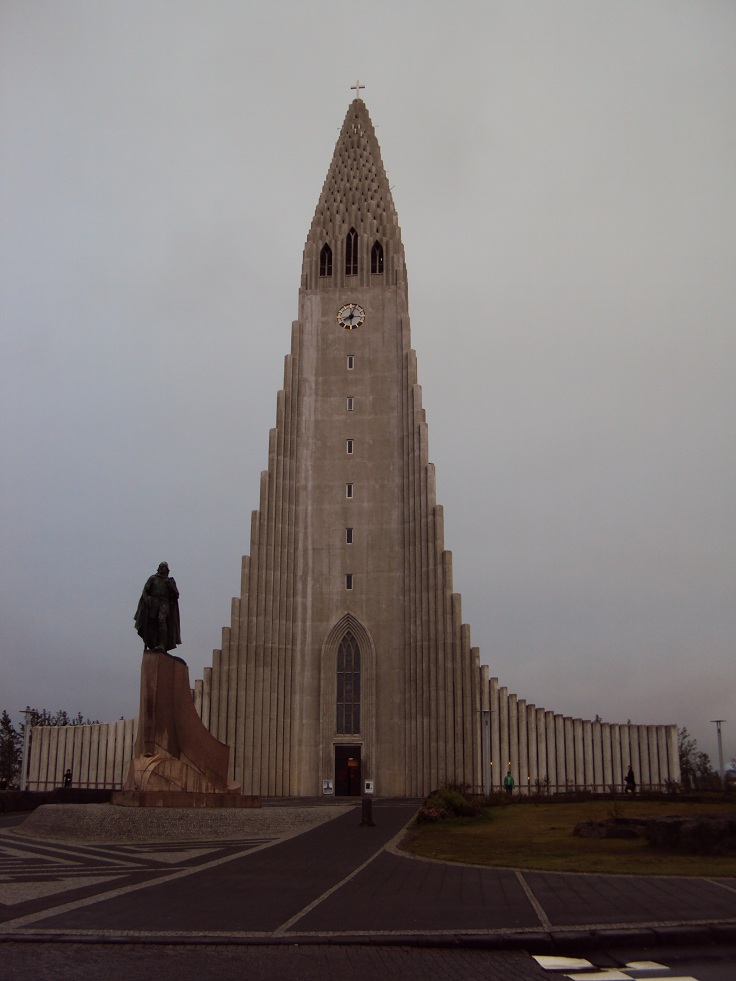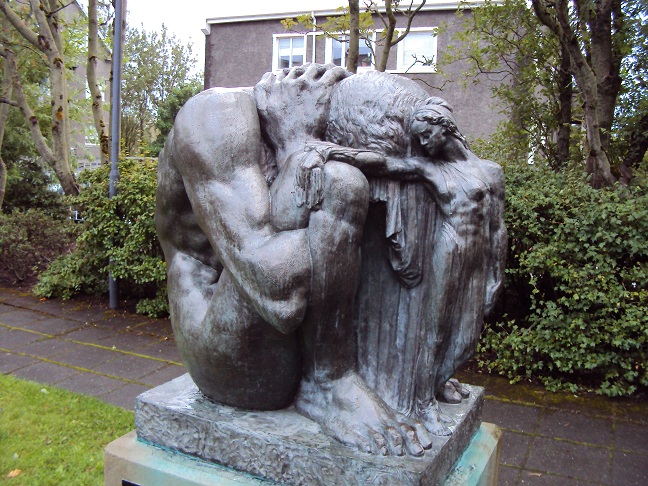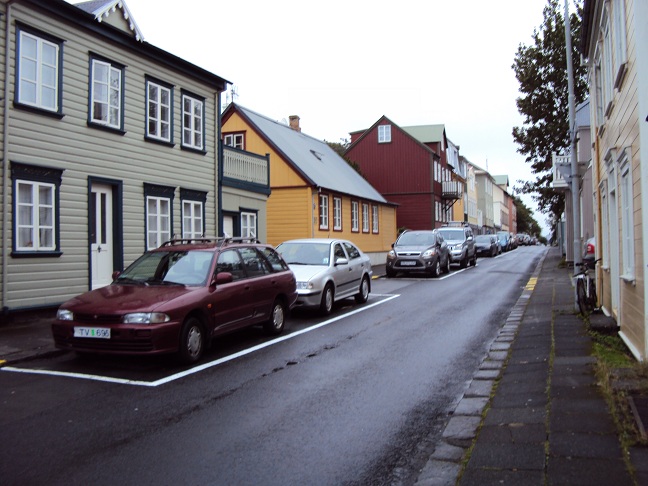Reykjavik´s most prominent visual landmark is the Hallsgrimskirkja named after Hallgrimur Petursson, a 17th century poet whose haunting hymns I have recordings of at home. It´s a twentieth century structure, in concrete, but it´s style so successfully fuses modern and gothic elements that it has a “timeless” look. It is equally pleasing in the interior. The statue in front of it is of Leifur Eiríksson (Leif Ericson). The residential streets around it have a pleasant jumble of old and new houses. Serious, Lutheran-looking cats peer from the windows. Next to it, there’s a rather spooky little enclosed garden filled with the sculpture of Einar Jonnsson, and a museum devoted to him. His work might best be described as “heroic fantasy”. In this garden setting, it is quite enchanting. I don´t think it would look as good in the cold light of a gallery.
The houses in this neighbourhood (the “101” postal code, made familiar in a movie title) has many of Reykjavik’s oldest houses, many with stern, Lutheran-looking cats peering out their curtained windows. The older ones generally mix well with the newer ones, since both have very simple, un-ornamented styles. A few have some restrained gingerbread. But one looked quite bizarre — a weird mixture of high Victorian gables, Italianate porches and steps, and a bit of Hollywood vulgar of the 1920s. It was abandoned, boarded up, and decaying, something entirely out of place in neat-and-tidy Iceland. With a large yard, rusted gate, and a scraggle of semi-wild vegetation, it looked haunted. With ghosts trotting around Iceland in great numbers, you would expect it to possess one. But when I asked an Islander who lived nearby who lived in it, she explained that it had been built by a rich eccentric long ago, then abandoned, been owned by the city for a long time, then sold to a Norwegian artist who let it run down further, then sold again to one of the Bankboomers, who intended to renovate it. That brought it up to 2008, and of course, that prospect evaporated in the crash. But no ghost. Countless ghosts haunting Iceland, and none of them bright enough to install itself in a prime location.
I had two extemely productive discussions with historians at the University (Háskoli Islands).
Guðmundur Halfdanarson is an affable, impish historian of the City of Reykjavik, and he had all the facts I needed at his fingertips. His office is a hobbit-hole, stuffed not only with books, but with hundreds of models, toy vikings, trolls and gnomes. A few minutes in his company put me at ease for meeting Icelandic academics. They seem to quite approachable. I leaned that the town of Hafnarfjörður, just to the south, had been a candidate for the nation’s capital until it was realized that the lava fields around it made it difficult to get to by land (communication by sea was still the Icelandic norm at the time). But most of my questions concerned municipal structure and the division of powers. There is no multi-tiered system of administration. Mayors in the past has substantial direct powers, and used them autocraticaly if they were so inclined. Only in recent decades has their power been curbed, and a greater distinction made between administrative and political functions. Municipal politics is party-based (unlike in Canada), but voting patterns and loyalties aren’t the same on the municipal and national levels. The national political parties could claim specific towns as bailiwicks. However, the current situation in Reykjavik is a historical anomaly. Abruptly, after the financial crisis, the angry voters put in power a “joke party” composed of artists, bohemians, and activists. The nation’s best-known comedian is now the mayor — much to his own surprise. This group is now trying to face up to the problem of running a real government. Anyone can imagine the kind of disasters that can happen in this type of situation, but no serious ones seem yet to have developed. They have been neither dramatically successful nor unsuccessful so far, but they are widely perceived as a coterie primarily interested in the chic “101” neighbourhood. We spoke of a number of urban issues, but this, and the fact that the Danish cultural influence in the city’s history has been overstated in the books I’ve read are what I remember most.
Eggert Thor Bernhardsson is the head of the Department of History and Philosophy, and somewhat more urbane and less impish, but our talk was very long, and went into great depth. I found him fascinating. He was able to describe in succinct, evocative phrases the social psychology that preceded the financial meltdown, and its subsequent effects. His views confirmed many of my guesses. He pointed out that the crash involved a genuine collapse of the country’s financial institutions, and this was the doing of genuine crooks, but the national finances were not particularly out of order at the time. The state had not run up great debts during the boom. The consequences for most Icelanders were not dire, and the present level of employment is higher than most of Europe. Icelanders still enjoy a high standard of living, though their delusion that they had discovered a money mill, like the Gods possessed in the Vǫluspá, and many of their luxuries have vanished. Problems created by a disastrously devalued currency remain, and their solution is not obvious. At the moment, a number of prominent Islanders are proposing that the country adopt the Canadian Dollar as its currency. The party in power pins its hopes on the EU. Neither of these strike me as particularly good ideas. Our discussion ranged over wide fields in economics an history, but focused on these points for the most part. The discussion was exactly the sort of thing I came to Iceland to experience.



0 Comments.